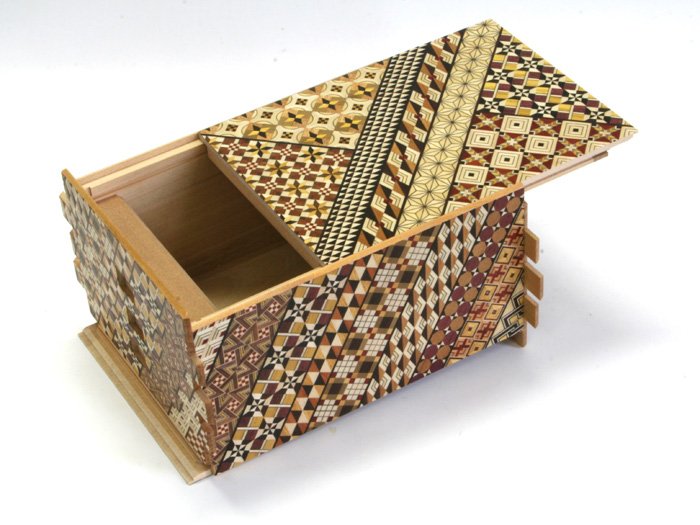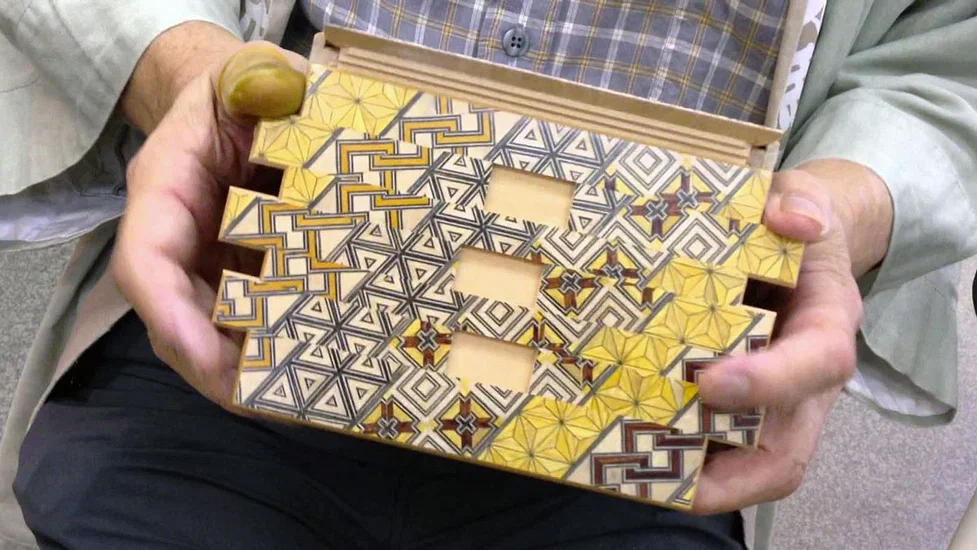
06 Aug Japanese Puzzle Boxes: A Fascinating Tradition
If you are a puzzle enthusiast or someone who appreciates intricate craftsmanship, Japanese puzzle boxes are sure to captivate your imagination. These beautiful and enigmatic creations have been captivating people worldwide for centuries.
In this article, we will dive into the world of puzzle boxes, exploring their history, unique features, and the secrets behind their mesmerizing design. So, sit back, relax, and let’s embark on this intriguing journey!
What are Japanese Puzzle Boxes?
Japanese puzzle boxes, also known as Himitsu-Bako, are traditional wooden boxes that feature a complex series of hidden compartments, secret panels, and clever mechanisms.
They are designed to open in a specific sequence, and discovering the correct steps to unlock the box can be a challenging and rewarding experience. The art of crafting these boxes has been passed down through generations of skilled artisans, making each puzzle box a true work of art.
Types of Japanese Puzzle Boxes
Japanese puzzle boxes come in various types, each with its unique design, complexity, and number of moves required to unlock them. Here are some of the most common types:
- 2-Moves Puzzle Box: As the name suggests, this type of puzzle box requires only two simple moves to open. It is an excellent choice for beginners and a great way to introduce yourself to the world of Japanese puzzle boxes.
- 5-Moves Puzzle Box: Slightly more challenging than the 2-moves box, the 5-moves puzzle box offers a bit more complexity, requiring five sequential moves to unlock its hidden compartments.
- 12-Moves Puzzle Box: The 12-moves puzzle box is a popular mid-level challenge. Solving this box requires a series of twelve precise moves to reveal its secrets.
- 36-Moves Puzzle Box: A true test of patience and skill, the 36-moves puzzle box is a more advanced option for seasoned puzzle enthusiasts. Unlocking this box demands careful observation and a deep understanding of its intricate mechanisms.
- Yosegi Puzzle Box: Yosegi puzzle boxes are known for their exquisite craftsmanship and intricate patterns created using the traditional Yosegi-Zaiku technique. These boxes often feature beautiful mosaic-like designs, adding an extra layer of visual appeal.
- Karakuri Puzzle Box: Karakuri puzzle boxes are the pinnacle of Japanese puzzle box craftsmanship. They are often equipped with clever mechanisms and hidden surprises. Some Karakuri boxes incorporate elaborate mechanical elements, making them both challenging puzzles and stunning pieces of kinetic art.
- Trick Opening Boxes: Trick opening boxes are designed to deceive the solver with false moves and tricky mechanisms. They require keen observation and a sharp mind to decipher the correct unlocking sequence.
- Modern Electronic Puzzle Boxes: While traditionalists may prefer mechanical puzzle boxes, some modern adaptations incorporate electronic components, adding a touch of innovation and excitement to the puzzle-solving experience.
These are just a few examples of the diverse range of puzzle boxes available. Each type offers a unique and engaging challenge, making them perfect gifts for puzzle enthusiasts or treasured collectibles for those who appreciate the artistry and craftsmanship of these fascinating creations.
A Glimpse into Their History
The origins of Japanese puzzle boxes can be traced back to the Hakone region of Japan during the Edo period (1603-1868). The samurai craftsmen in this region initially created these puzzles as a form of entertainment for the elite. Over time, their popularity spread, and the crafting of puzzle boxes evolved into a cherished tradition.
Craftsmanship and Design
Japanese puzzle boxes are meticulously handcrafted from high-quality wood, such as Koyamaki, Karaki, and Katsura. The artisan’s expertise lies in the precision and accuracy with which they design the hidden mechanisms.
Some puzzle boxes may have over a dozen moves required to unlock them, adding to the intrigue and complexity of the puzzles.
Each box features a unique design and motif, often inspired by nature, traditional symbols, or historical stories. The exquisite woodwork and attention to detail make them a delightful decorative piece even when they are not being used as puzzles.
The Joy of Solving Japanese Puzzle Boxes
The process of unraveling a puzzle box can be both challenging and meditative. It requires patience, observation, and a keen sense of problem-solving.
As you manipulate the box and unlock each hidden compartment, a sense of accomplishment and wonder fills you. It’s a tactile experience that provides a welcome break from the digital world.
Collectibility and Cultural Significance
The puzzle boxes have gained popularity worldwide, attracting collectors and puzzle enthusiasts alike. As the craftsmanship behind these boxes becomes increasingly rare, their value as collectibles continues to rise.
Additionally, the puzzle boxes serve as a testament to Japan’s rich cultural heritage and the ingenuity of its artisans.
FAQs (Frequently Asked Questions)
Q: How many types of Japanese puzzle boxes are there? There are several types of puzzle boxes, each distinguished by its design, level of complexity, and number of moves required to unlock it. Some common types include the 2-moves box, the 36-moves box, the Yosegi box, and the Karakuri box.
Q: Are Japanese puzzle boxes suitable for all ages? While puzzle boxes can be enjoyed by people of all ages, some boxes may be more challenging and intricate, making them better suited for older children and adults.
Q: Can I use Japanese puzzle boxes for storing small items? Yes, absolutely! The puzzle boxes not only make for fascinating puzzles but also serve as functional and beautiful storage solutions for small trinkets, jewelry, or other precious items.
Q: Are Japanese puzzle boxes made sustainably? Many artisans who craft puzzle boxes are mindful of sustainable practices and use responsibly sourced wood. By purchasing puzzle boxes from reputable sellers, you can support eco-friendly craftsmanship.
Q: Can I find modern adaptations of Japanese puzzle boxes with electronic components? While traditional Japanese puzzle boxes are purely mechanical, some modern adaptations may incorporate electronic components for added flair. However, purists often prefer the traditional, handcrafted versions.
In Conclusion
Japanese puzzle boxes are not just ordinary puzzles; they are an embodiment of art, culture, and ingenuity. From their rich history in the Edo period to the masterful craftsmanship that goes into making each piece, these boxes continue to captivate puzzle enthusiasts and collectors worldwide.
Whether you are an avid puzzle solver or simply someone who appreciates exquisite craftsmanship, a Japanese puzzle box is sure to spark joy and fascination in your heart.
So, why wait? Dive into the world of Japanese puzzle boxes and experience the joy of unlocking their hidden secrets, one move at a time!




No Comments